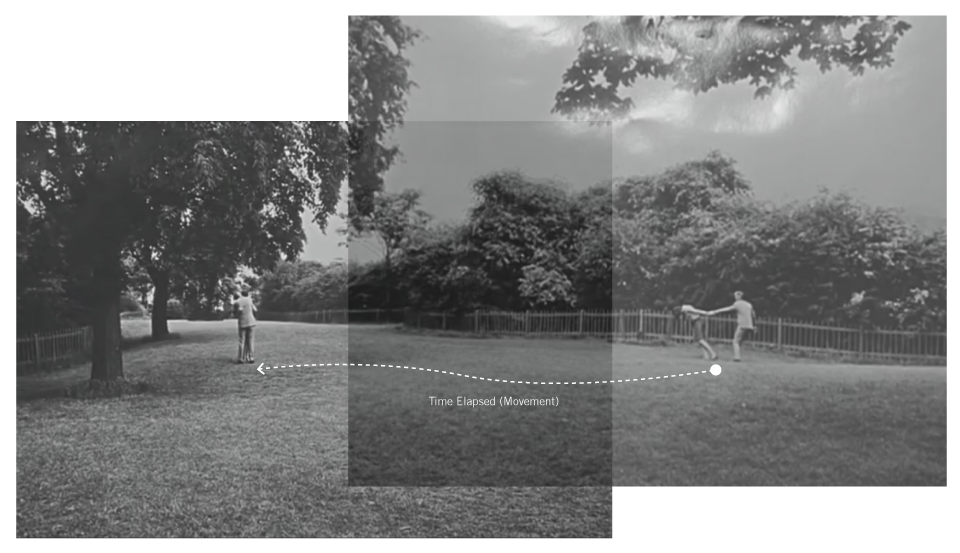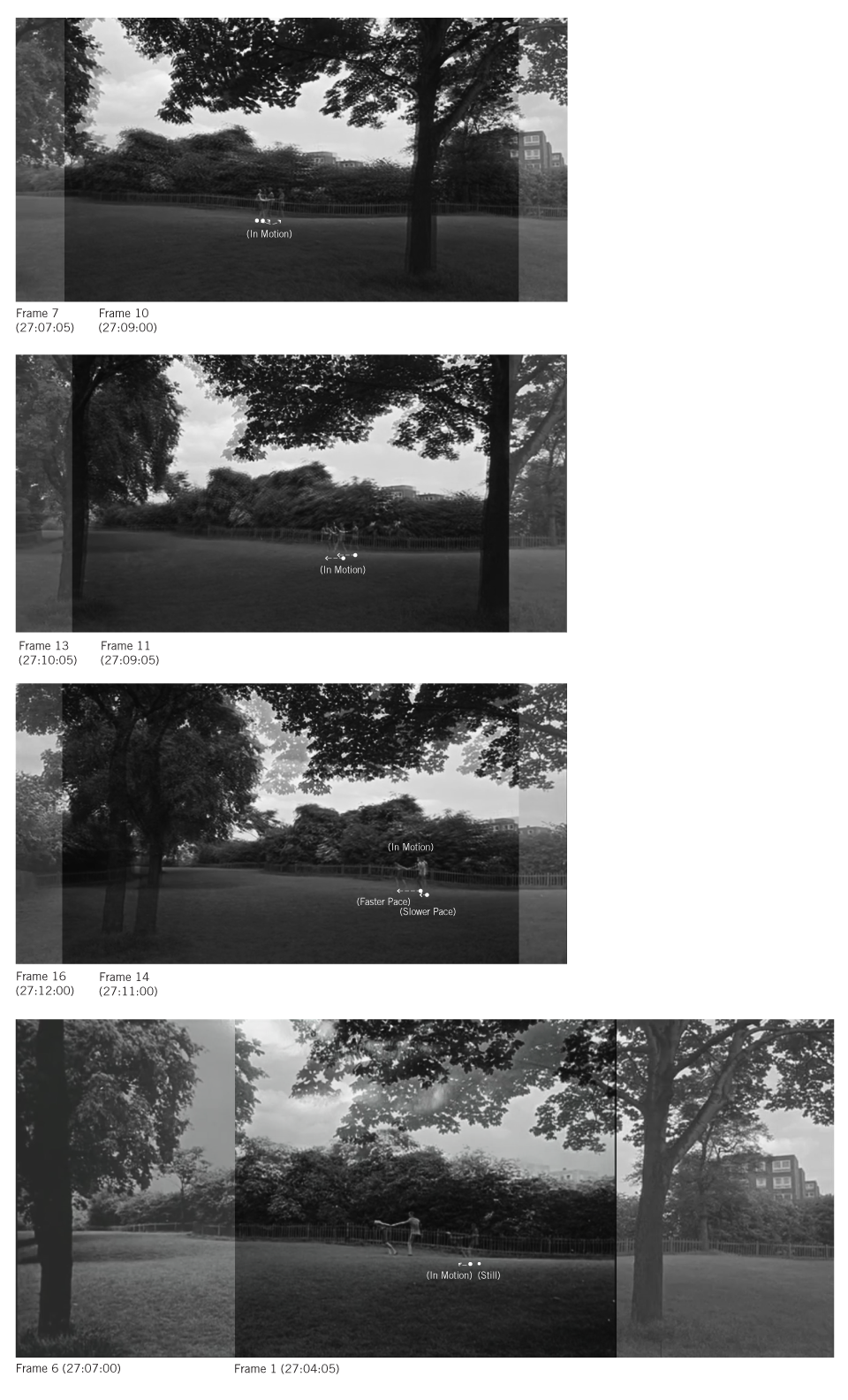︎Work
Blow Up / Play Pause
Philosophy of Technology
April 2015
Philosophy of Technology
April 2015
Instructed by: Jake Matatyaou
AT: Ana Derby
AT: Ana Derby

The camera is perhaps the piece of technology most focused in Antonioni's "Blow Up" (1966). The characters, events and plot are revolved around the protagonist’s use of camera. The scene that required a technological substitution is about half way through the movie when the protagonist blows up photos he took to search for larger details of a girl within those photos, but accidentally discovers a third person hiding in the background and reveals a murder plot. The protagonist then looked further into the collection of images he took, hoping to find more clues as to who the murderer is by enlarging photographs and visually identifying elements within the pictures. Would the story have unfolded the same way if the tool featured wasn’t a camera? This project proposes a change of technology from an analog photo camera to a video camera.
![]()


Frame (Singular)
With a single frame, one can only inspect so much in a scene as one is forced to take into account every single object in the scene and treat them as of same importance. The amount of frames (fps) a camera records is limited by how quickly the shutter mechanism is able to reset to its original position. The standard fps of a camera ranges from 3-6 fps per second.
The camera preserves a frozen moment of time by briefly exposing a frame on a roll of film to light. The amount of frames (fps) is limited by how quickly the shutter mechanism is able to reset to its original position. The standard fps of a camera ranges from 3-6 fps per second. The video camera, on the contrary, captures a ‘moving image’ by constantly exposing frames to a running roll of film. It is also limited to a certain amount of fps, but the basic fps of a video camera is much higher than that of a regular camera (about 36 fps/sec), thus tricking the human eye by creating the illusion of movement.
Method: Magnification
The still photograph inspection is based on the method of enlarging certain parts of a single (or multiple) photograph. Through visual analysis, one tries to search for clues that will help decide where and what to look for in the camera frame, or reveal what is beyond the frame. This method is executed in the movie by the protagonist as he traces his subject’s line of sight and discovers an armed person hiding in the bushes.
With a single frame, one can only inspect so much in a scene as one is forced to take into account every single object in the scene and treat them as of same importance. The amount of frames (fps) a camera records is limited by how quickly the shutter mechanism is able to reset to its original position. The standard fps of a camera ranges from 3-6 fps per second.
The camera preserves a frozen moment of time by briefly exposing a frame on a roll of film to light. The amount of frames (fps) is limited by how quickly the shutter mechanism is able to reset to its original position. The standard fps of a camera ranges from 3-6 fps per second. The video camera, on the contrary, captures a ‘moving image’ by constantly exposing frames to a running roll of film. It is also limited to a certain amount of fps, but the basic fps of a video camera is much higher than that of a regular camera (about 36 fps/sec), thus tricking the human eye by creating the illusion of movement.
Method: Magnification
The still photograph inspection is based on the method of enlarging certain parts of a single (or multiple) photograph. Through visual analysis, one tries to search for clues that will help decide where and what to look for in the camera frame, or reveal what is beyond the frame. This method is executed in the movie by the protagonist as he traces his subject’s line of sight and discovers an armed person hiding in the bushes.

Frame (Numerous)
With multiple frames, however, one is able to establish a hierarchy among the elements of inspection. With a short glimpse into an elapsed specific time and space, one can easily distinguish what can thought to be a UFO in a still frame to what is actually a Frisbee in multiple frames. The video camera captures a ‘moving image’ by constantly exposing frames to a running roll of film. It is also limited to a certain amount of fps, but the basic fps of a camera is much higher than that of a regular camera (about 48 fps/sec), thus tricking the human eye by creating the illusion of movement.
The immediate change after the technology has been substituted would be the method of inspection done by the protagonist. He would be dealing with a series of frames instead of a single frame - which in turn provides him with more information to inspect. His method of inspection would be different from enlarging or ‘blowing up’ photos, and would most likely be comparing frames in the video and inspecting subtle changes within each frame to reenact the scene. The advantage of having a series of moving frames over a single frame is that there will be sufficient information for one to establish a hierarchy among the objects within the scene. Through observation, one is able to identify and filter elements according to their movement and behavior (i.e. One can easily distinguish what can thought to be a UFO in a still frame to what is actually a Frisbee in multiple frames).
Method: Motion Analysis
Examined here is movement (motion) expressed in 4 different instances. There is a 1-2 second difference between most pairs above. Through such a simple analysis by adding just a single frame more to the original, one is already able to establish a understanding of motion within the frame by visually identifying a hierarchy of unfolding events. The subjects in these still pairs are in constant motion. The couple is frolicking in the seemingly empty park - but as it is later revealed that they are aware of a murderer in sight - it could be argued that the reason for them to be constantly moving is an attempt to dodge a potential gunshot.
![]()
With multiple frames, however, one is able to establish a hierarchy among the elements of inspection. With a short glimpse into an elapsed specific time and space, one can easily distinguish what can thought to be a UFO in a still frame to what is actually a Frisbee in multiple frames. The video camera captures a ‘moving image’ by constantly exposing frames to a running roll of film. It is also limited to a certain amount of fps, but the basic fps of a camera is much higher than that of a regular camera (about 48 fps/sec), thus tricking the human eye by creating the illusion of movement.
The immediate change after the technology has been substituted would be the method of inspection done by the protagonist. He would be dealing with a series of frames instead of a single frame - which in turn provides him with more information to inspect. His method of inspection would be different from enlarging or ‘blowing up’ photos, and would most likely be comparing frames in the video and inspecting subtle changes within each frame to reenact the scene. The advantage of having a series of moving frames over a single frame is that there will be sufficient information for one to establish a hierarchy among the objects within the scene. Through observation, one is able to identify and filter elements according to their movement and behavior (i.e. One can easily distinguish what can thought to be a UFO in a still frame to what is actually a Frisbee in multiple frames).
Method: Motion Analysis
Examined here is movement (motion) expressed in 4 different instances. There is a 1-2 second difference between most pairs above. Through such a simple analysis by adding just a single frame more to the original, one is already able to establish a understanding of motion within the frame by visually identifying a hierarchy of unfolding events. The subjects in these still pairs are in constant motion. The couple is frolicking in the seemingly empty park - but as it is later revealed that they are aware of a murderer in sight - it could be argued that the reason for them to be constantly moving is an attempt to dodge a potential gunshot.
